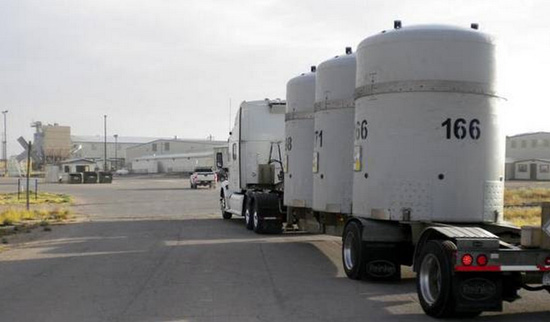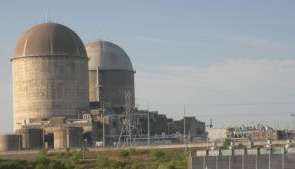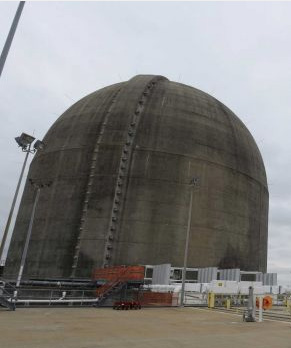Archive for the ‘News’ Category
Stealthily loading West Texas up with radioactive waste
18 June 2014
Dallas Morning News Editorial

U.S. Department of Energy
Waste Control Specialists is in talks to start receiving depleted uranium, and it wants to triple its West Texas site’s size.
The nuclear waste disposal site operated by Waste Control Specialists in West Texas is steadily morphing away from its original mission as a depository for very limited quantities of low-level radioactive items from Texas and Vermont. Today, the site is taking on much greater quantities and higher levels of radioactive waste from multiple states, and its owner wants permission to dramatically expand operations.
If this mission creep continues, Texans could find themselves the unwitting hosts of the nation’s first permanent for-profit high-level nuclear waste facility. If Waste Control’s intention is to build such a site, it owes Texans a straightforward, transparent declaration of these plans so a full public debate can occur.
This nation plunged headlong into nuclear research in the 1940s, followed in subsequent decades by production of thousands of nuclear warheads, construction of nuclear reactors and other radioactive devices used in hospitals and manufacturing. Throughout, everyone involved has confronted a nagging question: Where will all this radioactive waste be permanently stored?
No state wants such a sensitive and dangerous site. What region isn’t vulnerable to earthquakes, floods, fires or other potentially catastrophic events? With the inventory of waste continuing to rise, the only option has been to store it in temporary facilities around the country. That’s not a solution.
This waste has to go somewhere. If Waste Control’s facility northwest of Midland-Odessa is the nation’s best answer, then let’s have that discussion. Waste Control’s appearance of stealthily imposing a bigger footprint is cause for public skepticism.
When Waste Control sought a license in 2007, three members of the Texas Commission on Environmental Quality resigned rather than be party to it. The site sits atop the Ogallala Aquifer, and any radiation leak could risk contaminating a major water source for eight states. Waste Control maintains that the facility is state of the art, with multiple backup measures to avert accidents.
In April, Waste Control contracted with the U.S. Energy Department to store hundreds of truckloads of waste from nearly seven decades of nuclear research at New Mexico’s Los Alamos National Laboratory, where the world’s first atomic bomb was developed. Some of the waste comes from a temporary storage facility in Carlsbad, N.M., where radioactive leaks occurred in February.
What once was a two-state pact to house low-level waste now involves dozens of states. Waste Control is in talks to start receiving higher-level waste, including depleted uranium, at the same time it wants to triple the site’s size. Yet it wants to reduce the amount of money it is required to keep available if a disaster leads to large-scale liability claims.
Texans deserve to be part of this important discussion. But they can’t participate if they don’t even know it’s happening.
This document contains copyrighted material whose use has not been specifically authorized by the copyright owner. SEED Coalition is making this article available in our efforts to advance understanding of ecological sustainability, human rights, economic democracy and social justice issues. We believe that this constitutes a "fair use" of the copyrighted material as provided for in section 107 of the US Copyright Law. If you wish to use this copyrighted material for purposes of your own that go beyond "fair use", you must obtain permission from the copyright owner.
CPS Energy launches help team
June 24, 2014
By Vicki Vaughan
San Antonio Express-News

CPS CEO Doyle Beneby said the Customer Response Unit addresses a recurring concern.
CPS CEO Doyle Beneby said the Customer Response Unit addresses a recurring concern.
SAN ANTONIO — CPS Energy launched a new program Tuesday that’s designed to help customers take advantage of its energy efficiency programs and help those struggling to pay utility bills learn how to get assistance.
CPS CEO Doyle Beneby explained that in meetings with City Council, "one thing kept coming up — that we at CPS weren’t reaching all the places that we needed to" to inform customers about its services, especially its low-income assistance programs.
As a result, city-owned CPS has formed a new business unit whose mobile customer-service team will match CPS customers with the right program or service.
In some cases, the outreach employees will meet face-to-face with customers. Customers will be able to identify mobile team members because they’ll wear uniform shirts and drive hybrid vehicles bearing a Customer Response Unit logo.
The outreach plan is designed to make customers aware of various CPS programs that can help them manage or lower their utility bills.
The Casa Verde program, for example, provides an average of $5,000 in free home weatherization improvements for those who qualify.
District 5 Councilwoman Shirley Gonzales praised CPS’ new program, saying she’d initially asked the utility to send an employee to her district office a couple of days a week to help with customers’ problems.
"So this is beyond what our expectation was, because it was only going to be for District 5 residents," Gonzales said. "Now this will be for people in the whole city who need it. It’s a much more focused approach to help people."
Maria Koudouris, CPS’ community engagement vice president, said the outreach team will handle customers’ problems that can’t be handled by the utility’s call centers.
For example, if a senior citizen has fallen behind in paying a bill, it may be caused by the timing of a Social Security payment.
"We’ll set them up with a better payment plan … and we’ll take more of a holistic approach" to see if the customer qualifies for weatherization or another assistance program, Koudouris said.
To qualify for the weatherization program, a customer’s income must be no more than 200 percent of the federal poverty level.
"There’s a whole menu of programs that we have, and we’ll try to get a lot more customers into those programs," she said.
About half a dozen CPS employees will be part of the outreach group "and it could grow from there," CPS spokeswoman Lisa Lewis said.
Koudouris said CPS initially will work with Merced Housing Texas, a nonprofit that provides affordable housing, and the George Gervin Youth Center to get the word out.
Chuck Landy Jr., vice president of community and government affairs at the Gervin center, said it receives many calls from people asking how they can get help in paying their utility bills.
"This assistance from CPS will make a difference," Landy said.
Gervin center officials plan to aid the CPS team by doing their own outreach to tell the community about CPS programs.
"We’ll bring in all of our resources at the Gervin center," Landy said.
Also Tuesday, CPS said it is extending summer hours at its customer service centers to 7:30 a.m. to 8:30 p.m. Monday through Friday for residential customers.
Saturday hours — 8 a.m. to 5 p.m. — remain the same.
This document contains copyrighted material whose use has not been specifically authorized by the copyright owner. SEED Coalition is making this article available in our efforts to advance understanding of ecological sustainability, human rights, economic democracy and social justice issues. We believe that this constitutes a "fair use" of the copyrighted material as provided for in section 107 of the US Copyright Law. If you wish to use this copyrighted material for purposes of your own that go beyond "fair use", you must obtain permission from the copyright owner.
Energy Future Holdings approved for loan
June 10, 2014
Staff Report
YourGlenRoseTX.com

Energy Future Holdings, owner of Luminant which operations Comanche Peak Nuclear Power Plant, has received bankruptcy court approval for a multi-billion dollar loan to continue operating while in Chapter 11 bankruptcy.
The parent company of Luminant, which operates Comanche Peak Nuclear Power Plant north of Glen Rose, received court approval for a multi-billion dollar loan to sustain its retail electric operations while in bankruptcy proceedings.
Energy Future Holdings, Texas’ largest power company, which filed for Chapter 11 bankruptcy for $40 billion in debt in April, received bankruptcy court approval to borrow $4.5 billion to keep its generation and retail business running while under court protection.
EFH will use the new debt to pay the bills for its retail electricity and generator businesses as it restructures.
EFH filed for bankruptcy in late April, one of the largest bankruptcies of a non-financial company since the 1980s. The company is working on a restructuring plan to slash its $42 billion in debt.
The financing proposal is standard practice in bankruptcy.
It wants to use the loan as a mechanism to refinance its senior bonds and, in the process, quiet demands for some $690 million in early payment premiums. When Judge Christopher Sontchi signed off on the loan and an associated settlement, investors holding less than half the nearly $4 billion in senior bonds had agreed to the settlement.
Property taxes collected from Luminant and Comanche Peak account for more than 80 percent of the county’s tax revenue.
This document contains copyrighted material whose use has not been specifically authorized by the copyright owner. SEED Coalition is making this article available in our efforts to advance understanding of ecological sustainability, human rights, economic democracy and social justice issues. We believe that this constitutes a "fair use" of the copyrighted material as provided for in section 107 of the US Copyright Law. If you wish to use this copyrighted material for purposes of your own that go beyond "fair use", you must obtain permission from the copyright owner.
Concerns aplenty on nuclear waste
MAY 30, 2014
San Antonio Express-News Editorial Board

This is the South Texas Project electric generating station near Bay City. The state is now examining the possibility of creating a high-level nuclear waste dump. The idea raises environmental concerns. Photo: Express-News File Photo / San Antonio Express-NewsPhoto By Express-News file photo This is the South Texas Project electric generating station near Bay City. The state is now examining the possibility of creating a high-level nuclear waste dump. The idea raises environmental concerns.
SAN ANTONIO — Gov. Rick Perry is pushing for a high-level radioactive waste facility. And state Speaker Joe Straus has asked a House committee to wrestle with the issue of creating such a facility — perhaps in West Texas.
There are perfectly legitimate concerns attached; each one must be satisfactorily answered. If they can’t be, Texas simply shouldn’t allow such a facility.
Can it be safely stored?
We’re not talking about low-level radioactive waste, a site for which Texas already has. High-level radioactive waste generally involves spent nuclear rods, potentially deadly even with brief exposure. Safety must be as ironclad a guarantee as is technologically possible given the life of this waste — thousands of years. No corners should be cut.
Can it be safely transported?
Accidents and human error happen, and when they do, they will potentially affect even more people during waste transport than at a facility at a remote site. But a site in West Texas — which is widely viewed as the likely location if one is built — likely means transporting waste on Interstate 10, right through San Antonio and other population centers. Ditto, if by rail. The industry contends that casks developed for transport are safe. The committee must test that.
Can the waste be stored as effectively where it is produced?
In Texas, this would be at each of the state’s four nuclear plants.
Environmentalists credibly argue that dry cask storage at nuclear plants cuts out the middle-man — transportation. If this is the case, why create a large site with a lot of waste? To endanger only one part of the state rather than four?
Will safety or economic impact be the trumping factor?
It should be safety.
Environmentalists fear that Straus’ charge to the committee involves looking only at the economic impact of a facility. Such a site will likely be privately operated like the existing low-level site in Andrews County, run by Dallas-based Waste Control Specialists.
If this site is expanded or another picked, this means needed jobs and tax revenue. Environmental issues will be considered, the Speaker’s Office said.
"This charge was referred to the Committee on Environmental Regulation so they can conduct a thorough review for possible nuclear storage and will hear from all stakeholders to ensure that environmental, economic and regulatory issues are considered," according to a statement provided to the Editorial Board.
Will the decision be based on need or on the clout of political heavyweights?
There is the need. Like it or not, the state has four nuclear plants. These produce waste. If we use the power, we have to live and deal with the waste also generated.
But it’s been widely noted that Harold Simmons, the late owner of Waste Control Specialists, gave Perry roughly $3 million — some going to Perry’s campaign committee, other amounts to the Republican Governors Association when the governor was raising money for it.
Perry has been pushing for this high-level radioactive waste site. Part of the task for Straus’ committee is to determine whose need is being served here.
Will this be for Texas-only waste or will it take other states’ waste as well?
The federal government has botched identification and creation of a national repository. The Obama administration has given up on Yucca Mountain in Nevada. And a federal court in November, noting the disarray on this issue, told the feds they could no longer collect fees from utilities for waste storage since there is no federal facility.
States have formed compacts with other states for storage of low-level waste.
So, is Texas or a private entity operating a state site maneuvering for the state to become a national repository? And if not, are they positioning themselves to take other states’ waste?
The answer has to be "no" to both but particularly on the first proposition.
Straus’ committee should consider these and all other pertinent factors.
This document contains copyrighted material whose use has not been specifically authorized by the copyright owner. SEED Coalition is making this article available in our efforts to advance understanding of ecological sustainability, human rights, economic democracy and social justice issues. We believe that this constitutes a "fair use" of the copyrighted material as provided for in section 107 of the US Copyright Law. If you wish to use this copyrighted material for purposes of your own that go beyond "fair use", you must obtain permission from the copyright owner.
Hearing on Implementing the Nuclear Waste Policy Act
Hearing on “Implementing the Nuclear Waste Policy Act – Next Steps,” Subcommittee on Environment and the Economy (September 10, 2013)
Nuclear Power and Radioactive Waste Environment and Energy
Subcommittee on Environment and the Economy (113th Congress)
Sep 10, 2013
2123 Rayburn House Office Building
The Subcommittee on Environment and the Economy held a hearing on Tuesday, September 10, 2013, at 10:00 a.m. in 2123 Rayburn House Office Building. The hearing was titled, “Implementing the Nuclear Waste Policy Act – Next Steps.”


